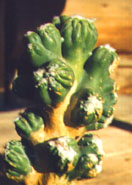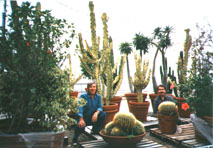HOW DO MUTANTS APPEAR?
I. M. Skulkin, Ph.D
 |
| Photo 1. |
The term mutation (from the Latin mutatio - "change") was used for the first time in the 19th century in geology to denote quick changes in fossil animals, so-called Vaagen mutations. In the beginning of the 20th century the term became wide spread in biology and denoted a completely different phenomenon. One of the founders of genetics, the Dutch scientist Gugo de Friz in his work "The theory of Mutation" (1901), used this term to denote a sudden, saltatory change of a hereditary feature. This is the modern meaning of the term mutation.
On Photo 1 - Sayansk district (Krasnoyarsk region, Russia) - a sow has produced a miraculous piglet. The piglet has three eyes, two snouts and three mouths, but lacked one leg. The owner didn't even know how to feed it. The monster had lived only for three days and now is stored in a freezer. The scientists of the Krasnoyarsk Research Institute of Cattle Breeding saw a pig, which had both a trunk and a snout. The cause of the pathology amongst animals and people can be inbreeding, a result of disorderly copulation. (Source: AiF - Novosti, April 16, 2000 - a popular Russian newspaper).
How do mutations and mutants appear? Why usually we don't come across such abnormal specimens in habitat ("a natural can't be ugly" - a Russian saying), but more and more mutants occur amongst household animals and plants, including our favorite cacti? I'll try to briefly answer these and similar questions.
It is necessary to point out that mutation is not a rare and unique, but rather a wide spread phenomenon. There are a lot of reasons for mutation. It can be caused by any sharp change in internal or external factors, such as temperature, acidity, ion contents, etc. However, ionizing radiations1 and specific chemical agents (mutagens)2 are the major factors of mutation. Therefore, a high radiation level and environmental pollution with chemical mutagens can considerably increase mutation rate in a certain area.
What will happen to an organism, either a cactus or a human being, placed in favorable and absolutely stable conditions in terms of temperature, nutrition, etc.? Will there be new mutations in his/its gene pool? Yes, they will occur anyway, though in much smaller quantities. Gene variations always happen - these are occasional mistakes that happen when copying genetic information, during doubling DNA before cell division. It is difficult to imagine a typist, who does not make a single misprint during the working day. And especially if she is being permanently distracted or frightened...
 |
| Photo 3. Monvilea spegazzinii. Collection of Mr. Serovaisky, V. M. (Moscow) |
This is the reason why mutations take place not only under some extreme conditions. They constantly happen within natural populations of any kind. This is so-called spontaneous mutagenesis, discovered in 1943 by American scientists Luria and Delbruckov. It is very important that emergent mutations in most cases are i) harmful and ii) recessive, i.e. they do not appear instantly. Let's dwell on these two facts, as both of them have much to do with the abnormal forms of cacti.
Why are these mutations typically harmful? Simply because the new mutant gene (or feature) is always an alternative or a challenge to an old gene, which has been proved during thousands of years of natural selection and has repeatedly demonstrated to be highly useful and profitable for the organism.
 |
| Photo 4. Photo 4. Euphorbia variegata (Plant in the background). Collection of Mr. Serovaisky, V. M. (Moscow) |
Why are mutations almost always recessive? For the same reason - the old dominant gene has already proved thousands times that it provides for the best adaptability in the certain environmental conditions. This is why it shows up as a stable, typical feature of the species. The value of the newly appeared gene is unknown and is not tested in practice yet.
As mutation process in nature is happening continuously, though at a variable rate, the populations in habitat resemble a sponge, full of water. The features of organisms, which we can see (the sponge itself) are the products of the old proven genes, providing the maximum adaptability. We don't see the water in the sponge, as we don't see millions of harmful recessive mutations hidden in the gene pool of heredity of any kind, including cacti.
If two organisms carrying the same harmful mutations are crossed, they will produce an offspring specimen, which at last possess this mutation phenotypically, i.e. outwardly. As the new mutation gene is harmful, the mutant will be soon destroyed either by predators, or pests, or will not leave offsprings, even if it manages to survive. If the mutation is extremely harmful, fatal or incompatible with life, the organism either will not appear at all, or will inevitability perish at once after coming up.
This is nothing but Darvin's natural selection, the most powerful factor that preserves beneficial features and according genes, and deletes external showings of harmful mutations. But all the mutation genes cannot be destroyed by selection, as selection works not immediately on genes, but only on mutant organisms.
***
Let's now return to our beloved cacti. Imagine a typical situation - after a new genus has been discovered, several dozens of plants are taken from the habitat and sent to Europe. A couple of them went to one collector, another couple ended up at another one's. Each person possesses only a micro population, a very limited sampling from the natural habitat. It is inevitable that sibbing, or inbreeding will take place amongst these species. The collectors distribute their seeds further and further. Finally, in some 20 or 30 years or in 2-4 generations, most of the genus will represent offsprings resulting from recurrent inbreeding.
Why is this extremely dangerous? Because in case of inbreeding, both parents may possess the same recessive mutations, and their offsets will have a high possibility of exhibiting the mutant feature. This is why variegated leaves occur, as well as chlorophyll-free, cristate and monstrose forms, double flowers, and spiral ribs instead of papillae and so on. The cause of these phenomena is recurring inbreeding, from generation to generation.
I think that in Russia, where majority of amateur collectors do not control genera purity and use domestic seeds of unknown origin, different anomalies and deformities are more common than in any other country, where amateurs acquire seeds from respected vendors and/or from habitat. I claim that if you sow only the seeds taken from natural habitat, mutations among seedlings will be practically impossible!
One more reason of a large number of mutations has been frequently mentioned by Russian amateurs - it is disorderly hybridization, pollination by whatever, including a blend of pollen from different species when it is extremely desirable to get seeds from a unique blooming specimen. I would like to refer to Kurt Backeberg's will, "Don't spoil cacti by a disorderly and random hybridization". Though I realize that even Backeberg can't argue against the "I-want-to-do-it..."
It is certain that hybridization, especially a remote one, "impairs heredity", as Acad. Michurin said. Remote, and not only remote hybrids have genes of different species all combined into a new pool. Therefore, some recessive mutant genes can unexpectedly become dominant. They will show up in phenotype as seedlings with various abnormalities. You may agree that use of pollen from other species not necessarily results in hybridization, but only stimulates self-pollination of a flower. But self-pollination is nothing but a pure inbreeding, which has already been mentioned.
***
Let's make a brief conclusion:
- Mutation is a typical natural phenomenon; it is not a unique and rare event. Mutation is not necessarily a result of any sharp change of external factors.
- Recessive and harmful mutations are accumulated in natural populations of any kind, forming a resource for hereditary variability.
- When mutations show up outwardly (phenotypically), the process of natural selection evaluates the new mutation feature and compares it to the old one. It very often imposes a death sentence on mutants - they perish.
- Plants brought from habitat into collections form a micro population, in which inbreeding is inevitable.
- Through generations, inbreeding inevitably leads to an increased percentage of mutations in next generations of cultivated plants.
- The longer the species is cultivated by people and the greater is the number of generations grown from seeds in collections, the more mutants will appear amongst the seedlings.
- If you are interested in pure taxa of cacti, it is necessary (while it's not to late!) to use seeds taken from habitat or at least from imported plants. If you're interested in new abnormal forms, than you should use seeds, produced by inbreeding, stimulated self-pollination and remote hybridization.
References:
1. Mednikov, B. M. Axioms of Biology (Biologia axiomatica). Moscow: Znanie, 1982.
2. Skulkin, I. M. The History of Biological Discoveries. Yekaterinburg, 2000.
3. Skulkin, I. M. Biologists, The Nobel Prize Laureates. 20th Century. Yekaterinburg, 2001.





